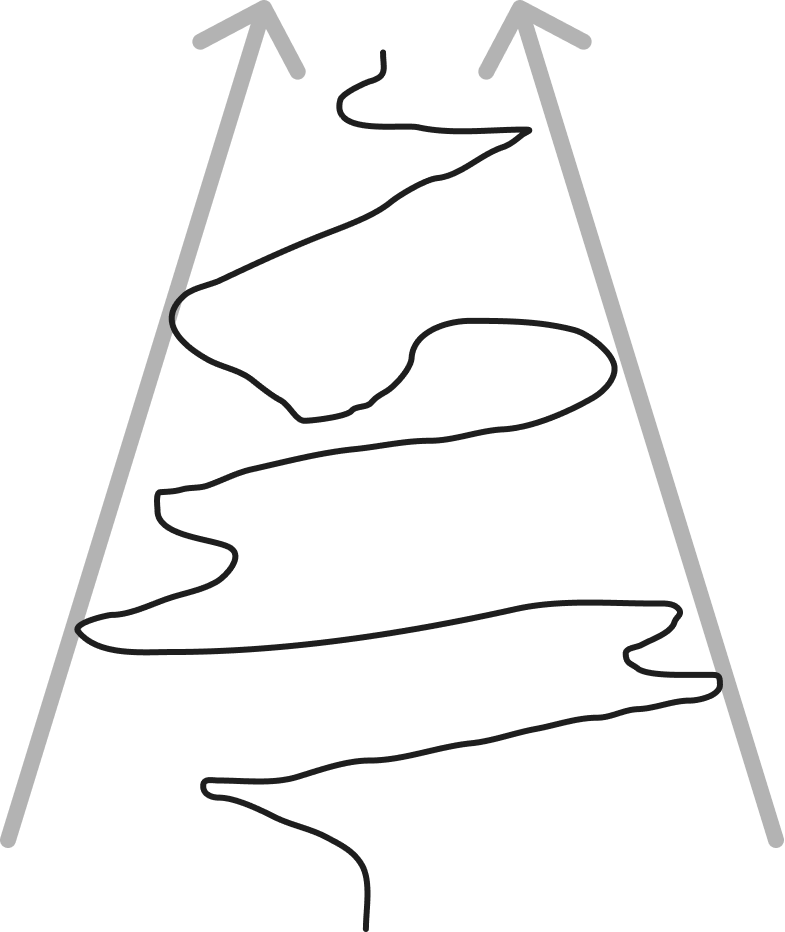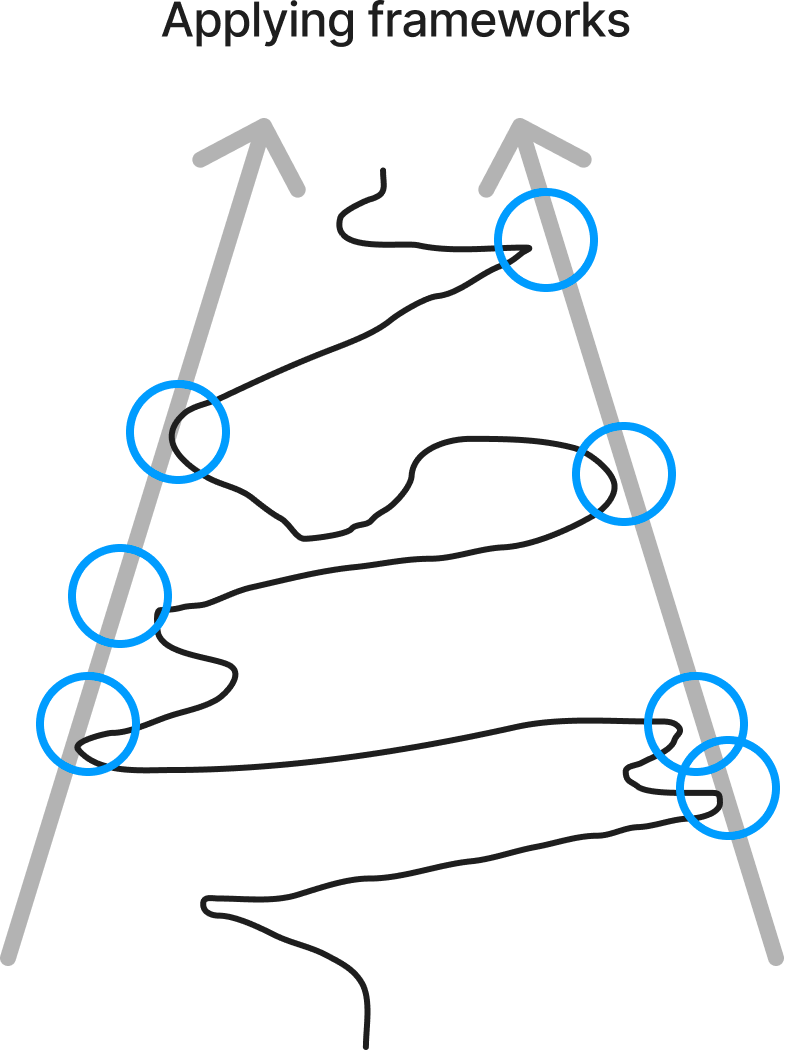Thanks to Eric Drymer from Studyverse for the title of this week’s post.
I’ve been spending a lot of time over the past couple of weeks diving deep into readings, resources, and more to help guide my ideation for pursing (dare I say) startup ideas.
As I think about ideas, I feel like I am progressing through a funnel towards a handful of options I could pursue:
This framework was partially inspired by a conversation I had with Ashwin Wadekar (his substack is here) where he told me he had narrowed the categories of ideas he wanted to explore into three fields. It got me thinking about how I could be better at being more specific about the categories I’d like to explore.
Part of knowing this funnel is knowing myself, knowing what’s out there, and applying frameworks towards guiding my path. These frameworks are refocusing-mechanisms towards going down the funnel, almost acting as the walls of the funnel. Each time I meet a framework, it reshapes and redefines the direction I should be going, whether further down the funnel, or to the side, but always forward towards something more specific.
These interactions with frameworks are all useful collisions to help guide my thinking while making sure I move forward along the tunnel.
Today I wanted to share some of the frameworks and resources I’ve found to have been significant collisions in my process of thinking through startup ideas. Some of them are just conceptual from my experience, while others I have linked from other people’s writing. The challenging part of ideation is that you are constantly bombarded with tons of new directions, and at the end of the day, advice is only as useful as much as it resonates with you and your own thinking.
Hopefully this will at least help those of you that are also ideating in navigating your funnel.
Ideation frameworks for startup ideas
Where to start ideating?
Paul Graham’s “How to do Great Work” – Following your curiosity for a long time is a great way to find ideas. This post is extremely long and may just be easier to listen to (1 hr, but you can speed it up). Paul Graham’s “What doesn’t seem like work?” is also a great way to isolate what you find is naturally interesting to you.
For me this is design – I don’t feel like it’s work and it comes quite intuitively for me. Probably because I’ve been drawing / designing all of my childhood, from comic books, to paintings, and more. Interestingly enough (and I can already tell Samir is rolling his eyes), I have been trying to distance myself from doing 100% design work. I know it will always be something I am interested in, but as of late I’ve been wanting to expand my scope beyond design.
Follow your childhood interests – If you were the type of kid to be interested in science, or languages, or Legos, those could be signs of the types of work you’d be interested in the future. It’s kind of like the “chose your toy” trope where a hero selects a toy to play with in their childhood and it foreshadows what they’ll do later in life. There probably is some truth to that process, but it is something I think is a more effective framework over time than just a one-moment decision.
Understanding yourself today
Your specific knowledge – A list of topics or skills that you feel you have an extremely high level of expertise in. Things that are obvious to you through your experience, or through your passions and interests. This is a more enhanced version of the childhood interests, just brought forward to who you are professionally today. This framework is great for helping niche yourself into a topic or category you find interesting.
A list of passions – What do you do for fun? Usually what you do for fun is something you’ll have some expertise in. Perhaps you could find a way to augment that hobby with a tool that would make it more enjoyable, or a community of other people that may resonate with it. If it happens to be a hobby you pay for like collecting clothing or a membership, maybe there’s something specific about that hobby you could build a business around.
A list of categories you are interested in – It’s helpful to have a list somewhere so you don’t have to keep revisiting these categories anytime you start the ideation process. As you go about collecting information from the world, you’ll start to consolidate and see opportunities within categories and adjacent fields. You’ll also start to disqualify categories. I think for those categories, make sure you keep them in the list, just
strike them throughand write down why so you can reference that decision in the future.What is obviously achievable within your skill set? – Something I chatted with Grant Wilkinson the other week about. What could you build today that you would absolutely smash out of the ballpark? In other words, what is an opportunity you think you’re overqualified to pursue, but that could be a medium to large win if you were to achieve the opportunity? It could be a useful exercise to write some of the obvious opportunities down. Going into a category you are overly optimistic or confident in is a good way to maintain momentum.
Finding Problems
A list of all of your life problems – Keep a list of problems, big and small, that you face in your own life. Especially be sure to categorize the problems you have in your work life, because a) if you’re experiencing it someone else probably is, and b) anything that helps you overcome work problems could be something that your employer would be interested in paying for. Ask your friends too for life problems – you never know when someone may say something that inspires you.
Tony Fadell’s Build – Working on something that you can’t stop thinking about for a very long time is a good way to validate that you’re interested in it. The biggest biggest takeaway from the book is that only important part of building a company is making sure you’re solving a problem. Sounds obvious, but is critical.
YC’s request for startups – This is a good high-level place to explore larger issues in the world, and something to pair with the categories exercise from earlier in the list.
Validating
Your customers are real people, not idealized people – I can’t remember where I heard this from, but it’s a healthy reminder. Anytime you discuss what a theoretical customer would want or try to predict what someone would pay for, just remember that there are real people in the world who you can just ask. This can be tough to swallow because it means being vulnerable out in the real world.
Sometimes just the wording on a landing page can be enough to convince someone to join a waitlist if the problem is critical enough.
People buy solutions to problems not because the technology is cool but because there is a job they are willing to pay for to get done.
On validating B2B startup ideas – if you’d like to build something in business, start with your network, and then cold-email customers. It’s how a surprising number of B2B startups got their first customers… Lenny writes about this:
Balancing the enjoyment of learning
The challenge with all of these frameworks on what to build is that some entrepreneurs just inherently enjoy the process of learning. I’ve certainly fallen victim to this many times before, where I’ll jump into an idea or a project, build it out, get it to a state of launch or almost launch, and then get bored with it.
The worst part about unlaunched projects is that they don’t produce any kind of signal. My guess is that when meaningful revenue or reaction or engagement starts to flow is when the feedback loop as to whether something is working starts to encourage motivation to continue, but its healthy to recognize that it may take a lot of time for this to start happening. Even this newsletter is a good example – It’s taken a while to get even you on the mailing list!
After all, all startups and projects are “default dead” (Sorry it’s another Paul Graham essay) and only after being around for long enough can something begin to sustain on their own without constant nurturing.
I definitely enjoy learning, and part of putting these frameworks down on paper is to help guide my specificity in the categories and problems that I’ll continue to be motivated to work on for a while.
At the end of the day the problem, not the product, should be enticing enough or critical enough to solve that it continues to be motivating for a founder to chase after.
Selecting where to go
I am still very much in the early stages of exploring ideas but so far, I’ve found these frameworks to get me closer towards landing on categories and problems I’m interested in pursuing.
If anything, the confidence boost of what to focus on may be reason enough to use them – they validate the process of thinking and can help guide it towards the right option.
The maximalist in me still is on the hunt for an idea that would get me excited to pursue yet is realistic with my given time, skills, interests, and resources. In many ways the excitement of an idea will be a good indicator of where to go, but I am hesitant to use that as the only signal, as historically it’s been more fleeting than reliable.
Sticking with the frameworks, writing down ideas, and striving to be more specific will hopefully build a stronger foundation for selecting what to pursue, as it is all an effort to accumulate evidence to support that whatever I end up choosing is worth the chase.





